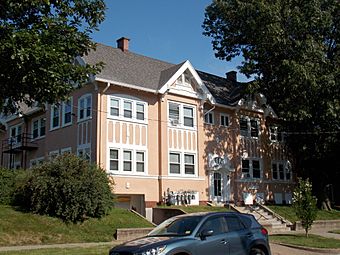Cork Hill District facts for kids
Quick facts for kids |
|
|
Cork Hill District
|
|

Eight-Gables at 1117 Perry Street
|
|
| Location | Perry, Pershing, Iowa, 11th, 12th, and 13th Streets, Davenport, Iowa |
|---|---|
| Area | 18.7 acres (7.6 ha) |
| Architect | Multiple |
| Architectural style | Greek Revival Italianate Victorian |
| MPS | Davenport MRA |
| NRHP reference No. | 84001334 |
| Added to NRHP | May 16, 1984 |
The Cork Hill District is a special historical area located in Davenport, Iowa. It's recognized across the country for its unique history and buildings. This district was added to the National Register of Historic Places in 1984. It covers about 18.7 acres and is home to many buildings that show different old architectural styles. These include Greek Revival, Italianate, and Victorian styles. The district stretches from Palmer College of Chiropractic on one side to the Sacred Heart Cathedral Complex on the other.
Contents
A Look Back at Cork Hill's History
Cork Hill is part of a larger area in Davenport called the LeClaire Reserve. This area was named after Antoine LeClaire, who owned the land and helped start the city. It was once a big neighborhood where many families from both Yankee and Irish backgrounds lived. The houses in the Cork Hill District show how this area grew over a long time.
How the Neighborhood Grew
The LeClaire Reserve developed in a unique way. This means that different styles of buildings were built next to each other on every block. Antoine LeClaire himself built his own home here in 1855. He also helped build St. Margaret's Church in 1856. Other important families, like the French family, also moved to this area. The French family was known for supporting arts and literature in the city. A famous writer named Alice French, who used the pen name Octave Thanet, was from this family. She was one of the first authors from Iowa to become well-known across the country.
Why It's Called Cork Hill
Many Irish people started moving to Davenport after the Great Famine in Ireland during the 1840s and 1850s. A large number of these Irish immigrants settled around St. Margaret's Church. Because so many Irish families lived there, the area became known as Cork Hill. Many of the Irish who moved here worked for the railroads or in the mills along the Mississippi River.
Most of the original houses built by Irish families were replaced later. This happened at the end of the 1800s and the beginning of the 1900s. Newer, larger homes were built instead. However, even though the old church was replaced by Sacred Heart Cathedral in 1891, the area around it is still called Cork Hill today.
Exploring Cork Hill's Architecture
The homes in the Cork Hill District show many of the main building styles from the 1800s. These houses are often simpler than those you might find in the Hamburg Historic District. That district was a German neighborhood located on a bluff nearby. The difference between these two areas shows how building styles were changed to fit different budgets and tastes.
Common House Styles
Most of the houses in Cork Hill are two stories tall and made of wood. They were usually built as homes for one family. However, there are also "double houses" in the district. You can tell these apart because they have two separate entrances.
The very first houses on Cork Hill were built in the Greek Revival style. This style was popular in Davenport when the city was first growing. Later, the Italianate style became popular in the 1850s. Antoine LeClaire's own house helped make this style well-known. After that, styles like Queen Anne and Gothic Revival became popular.
As the 1800s ended, the Colonial Revival style became more common. You can also see homes influenced by the American Craftsman and Victorian styles. A few houses even show influences from the Prairie School style of architecture.




